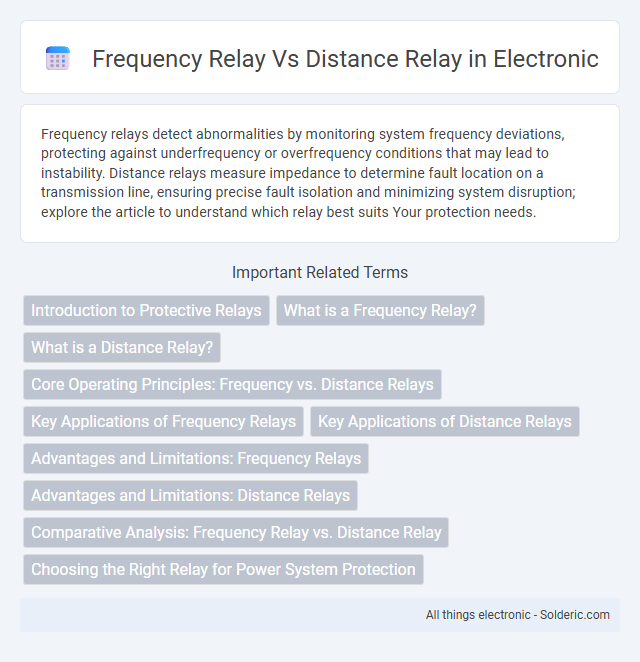Frequency relays detect abnormalities by monitoring system frequency deviations, protecting against underfrequency or overfrequency conditions that may lead to instability. Distance relays measure impedance to determine fault location on a transmission line, ensuring precise fault isolation and minimizing system disruption; explore the article to understand which relay best suits Your protection needs.
Comparison Table
| Feature | Frequency Relay | Distance Relay |
|---|---|---|
| Function | Monitors system frequency deviations to detect abnormal conditions | Measures impedance to identify fault location on a transmission line |
| Application | Frequency stability and load shedding in power systems | Line protection in transmission and distribution networks |
| Operating Principle | Triggers when frequency crosses preset thresholds | Operates based on impedance magnitude and angle from relay to fault |
| Fault Detection | Frequency abnormalities (e.g., over-frequency, under-frequency) | Short circuits and line faults within a defined zone |
| Response Time | Typically slower; involves frequency averaging | Fast operation to isolate faults promptly |
| Measurement Parameters | System frequency (Hz) | Voltage and current to calculate impedance (Ohms) |
| Protection Zones | Not zone-dependent | Multiple zones with adjustable reach settings |
| Typical Use | Grid frequency regulation and load management | Primary line fault detection and clearance |
Introduction to Protective Relays
Protective relays are essential in electrical power systems for detecting faults and initiating circuit breaker operations to prevent equipment damage. Frequency relays monitor power system frequency changes and trigger corrective actions when deviations indicate instability or faults. Distance relays measure impedance to the fault from the relay location, providing precise fault detection and isolation based on location and fault type.
What is a Frequency Relay?
A frequency relay is a protective device designed to monitor the power system's frequency and initiate a trip when the frequency deviates beyond preset limits, ensuring system stability and preventing damage to equipment. Unlike distance relays, which focus on impedance and fault location, frequency relays respond to the system's dynamic frequency changes caused by generation-load imbalances. Your power system relies on frequency relays to maintain operational integrity during disturbances by detecting over-frequency or under-frequency conditions quickly.
What is a Distance Relay?
A distance relay is a protective device used in power systems to detect and isolate faults based on impedance measurement between the relay location and the fault point. It calculates the apparent impedance by measuring the voltage and current at the relay site to determine the fault distance. This type of relay operates faster and is highly effective for transmission line protection compared to frequency relays, which monitor system frequency variations rather than fault location.
Core Operating Principles: Frequency vs. Distance Relays
Frequency relays operate by monitoring the power system's frequency deviations and triggering protective actions when frequency falls outside preset thresholds, thus preventing system instability and blackouts. Distance relays function by measuring the impedance between the relay location and fault points along transmission lines, providing fast fault detection and isolation based on the distance to the fault. While frequency relays primarily safeguard against system-wide frequency anomalies, distance relays offer precise, localized protection for line faults through impedance-based fault detection.
Key Applications of Frequency Relays
Frequency relays are primarily used to protect power systems from abnormal frequency deviations caused by generation loss or load fluctuations, ensuring system stability and preventing equipment damage. Key applications include under-frequency load shedding, generation trip detection, and islanding protection in both transmission and distribution networks. Your system benefits from frequency relays by maintaining operational reliability during frequency disturbances, complementing the distance relay's role in fault location and line protection.
Key Applications of Distance Relays
Distance relays are primarily utilized in transmission line protection to detect faults by measuring the impedance between the relay location and the fault point. They are essential for high-voltage power systems, providing rapid fault isolation and minimizing system disruptions. These relays ensure system stability by quickly isolating specific sections during short circuits or line anomalies.
Advantages and Limitations: Frequency Relays
Frequency relays offer rapid response times and high sensitivity to frequency deviations, making them ideal for detecting abnormal system conditions like generator trips or load shedding. Their primary limitation is the inability to pinpoint fault locations, reducing their effectiveness in complex power systems where precise fault isolation is critical. Despite this, frequency relays enhance system stability by providing fast protection against frequency-related disturbances.
Advantages and Limitations: Distance Relays
Distance relays offer precise fault location capabilities by measuring the impedance between the relay location and the fault point, improving system protection and reducing outage times. Their key advantage lies in high sensitivity and selectivity for detecting faults within specific zones, enabling faster and more accurate isolation of faults in transmission lines. Limitations include dependence on accurate line parameter data, potential instability during power swings, and limited effectiveness in complex network topologies or multi-terminal lines.
Comparative Analysis: Frequency Relay vs. Distance Relay
Frequency relays monitor system frequency deviations to protect against abnormal speed or load imbalances, primarily safeguarding generators and load stability. Distance relays evaluate the impedance between the relay location and fault point, offering precise fault location detection critical for transmission line protection. Frequency relays are faster in detecting grid disturbances, while distance relays provide greater selectivity and sensitivity for fault isolation in power systems.
Choosing the Right Relay for Power System Protection
Frequency relays monitor system frequency deviations to protect against underfrequency or overfrequency conditions, making them essential for grid stability and load shedding schemes. Distance relays measure impedance to detect faults within specific line zones, offering precise fault location for transmission line protection. Selecting the right relay depends on system requirements: frequency relays are ideal for frequency stability and load management, whereas distance relays provide fast and accurate fault isolation on transmission lines.
frequency relay vs distance relay Infographic

 solderic.com
solderic.com